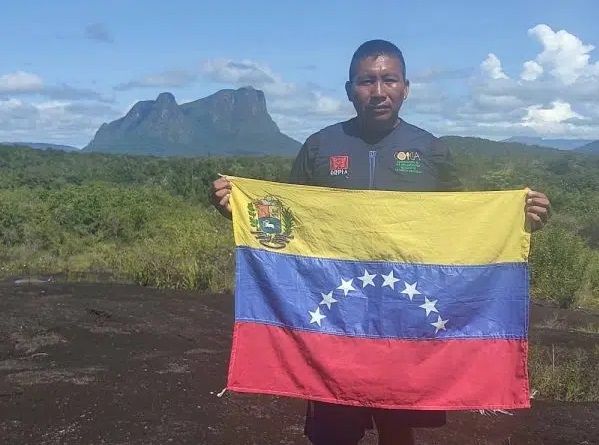In her last column for El Tiempo news, published on Wednesday June 12, Colombian journalist, Claudia Palacios, asked migrant Venezuelan women to “stop having children.” Palacios wrote:
“Dear Venezuelans, things here are not how they are in your country, and that is a good thing, with all of its subsidies, 21st-century socialism turned the richest country in the region into the poorest. The best way to be well-received here is to be aware that, despite internal problems, Colombia has made arrangements, like no other country, to receive you, but if you keep reproducing as you are, it will be hard to view you as an opportunity for development, instead of as a problem.”
In the same article, she also suggested that the Colombian government “should make controlling Venezuelans’ birth rate a priority in its migratory strategy.”
On the following day, within one hour, the hashtag #BienvenidasVenezolanas [“Welcome Venezuelan Women”], went from 29th place to second place of trending topics on Twitter in Colombia. The Colombian National Movement for Sexual and Reproductive Health tweeted that they were “in total disagreement” with Palacios’ column. They even regretted “having facilitated research for her book on empowering women” and withdrew their support. Daniel Samper Ospina, columnist for Semana, a Colombian magazine, said that the text promoted xenophobia. Palacios responded that she used official figures to show “the need to guarantee access to family planning for migrants,” and she added in another tweet that “what is fundamental and desired is that any person who wants to have children should first resolve their own subsistence.”
But talking about controlling birth rates is not the same as talking about family planning. In fact, the concept of controlling birth rates is obsolete because it implies imposing public policy above the right that each individual has to have children and start a family, according to Luisa Kislinger, internationalist and director of non-profit organization Mujeres en Linea. “Nobody talks about controlling birth rates today. That terminology was gone the moment we understood that this was about human rights, because people should be empowered to make free decisions in regards to their bodies and reproduction.”
The starting point was the International Conference on Population and Development in Cairo in 1994. At this conference, it was agreed that “ensuring women’s ability to control their own fertility” was one of the “cornerstones of population and development policies.” Over 180 country participated in negotiations to develop the Program of Action, which “focuses on meeting the needs of individuals —within the framework of universally recognized human rights standards—, instead of merely meeting demographic goals.”
With this shift in perspective, a new term came into use: reproductive autonomy. “This is the right for men and women to decide how many children they will have and when they will have them, and also the right to any supplies, information, assistance, and services in its exercise,” Kislinger explained. She noted that although the Cairo Program of Action is not an agreement, and therefore not mandatory for those countries, the document is a reference for reproductive rights and autonomy because, “conferences become standards, and they are an international law source that countries may use as a guide.”
Magdymar Leon, psychologist and executive coordinator for the Venezuelan Association for Alternative Sexual Education (Avesa), explained the difference between guaranteeing reproductive rights and imposing birth rate controls:
“The government should guarantee its people the services, education, and methods for people to be able to make free and responsible decisions about their sexuality. Controlling birth rates refers to imposing coercive limits that indicate how far you can go or how you should reproduce, such as in China, where the number of children per family is regulated. Or as it occurred in Peru, with the case of massive sterilizations during Fujimori’s rule.”
The Peruvian case is an extreme example of how the government could infringe upon women’s reproductive rights by using birth rate control. In 1995, during the Fourth World Conference on Women in Beijing, Peruvian President, Alberto Fujimori, presented his program for voluntary surgical contraception. In practice, it was a forced sterilization plan applied mainly to indigenous, poor women located in remote areas. To justify this, he used the phrase, “the women of Peru must be owners of their destiny.”
Palacios stated in her column:
“Every time that I see a Venezuelan on the street begging for money with a baby in their arms, I ask myself why people with a completely uncertain future, with a current situation of mere survival, would bring children into the world to suffer worse than their parents, since children are more prone to suffer lifelong consequences if they endure hunger, cold, heat, discrimination, etc.”
Leon used the example from Peru to point out that “you cannot tell a woman that because she has five children, she cannot have any more, or that she cannot be a mother because she is poor. It is the same for Venezuelan immigrant women.” Pregnancy for Venezuelan migrants cannot be treated as an “individual irresponsibility because behind that, there is the problem of violating human rights. It is true that in Venezuela there are young women with several children or pregnant. But what is behind that? They have not received any education, much less sexual education. They do not have the fundamentals to make informed decisions. There are difficulties in access to birth control, with an 80 to 90 percent shortage, and a lack of services.”
Colombia is the first receptor of Venezuelan migrants. It receives 1.3 million migrants, according to UNHCR, the UN Refugee Agency, followed by Peru, who receives 768,000, Chile (288,000), and Ecuador (263,000). According to Migration Colombia, between April and June 2018, some 8,209 pregnant Venezuelan women were recorded entering, of which 6,304 (76.7%) had no prenatal care.
The report “Migration from Venezuela to Colombia” from the World Bank warns that “care for Venezuela’s migrant population has put pressure on the already tight finances of several public hospitals, particularly in those cities with a greater flux of migrants. In May, Colombian Minister Carlos Holmes Trujillo called for more resources to respond to the Venezuelan migratory crisis, because they have only received 21% of the funds committed by international organizations. He stated that pregnant women make up over 20% of the total patients treated by the health system.
There are many pregnant women who cross the border from Venezuela to Colombia and resources run out, but telling them to “stop having children” or suggesting they control their birth rates is an approach that “blames women and infringes upon their human rights,” Leon warned. “Human rights are not conditioned by nationality. Moving to a different territory does not make you a second-rate person. There are no first or second-rate people.”
“The Venezuelan conflict stopped being solely Venezuelan as soon as people began to cross the border,” Kislinger said. To improve migrant conditions, she suggested sexual education and family planning programs to promote informed decisions, with the reminder that “men also have a right to reproductive autonomy” and should also be included. Meanwhile, they should be guaranteed access to birth control methods. “It does nothing to tell them how they can protect themselves, if they do not have the supplies to do so.”
However, these assistance programs should not only focus on prevention, they should also guarantee a pregnancy with no risks. “It cannot follow a single line. It should be a broad, comprehensive policy that incorporates access to health services, including pregnancy termination services, which are legal in Colombia for different cases.
“We have to remind them that human sexuality does not only have a reproductive purpose,” Leon said, in defense of sexual rights. “It is also about affection and pleasure, and migrants do not have to stripped of the right to sexual enjoyment.” The World Health Organization (WHO) recognizes that “in order for all people to reach and maintain sexual health, their sexual rights must be respected, protected, and fulfilled,” as these also encompass other human rights such as the rights to equality, non-discrimination, education, and a family.
[Photo: A woman stands on the Simon Bolivar international bridge that connects the Colombian city of Cucuta to San Antonio del Tachira in Venezuela. Photograph by Juan Barreto. AFP]




